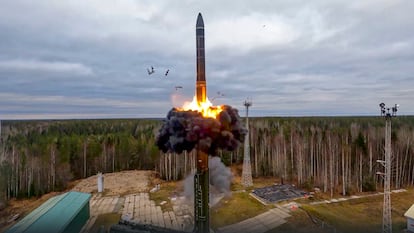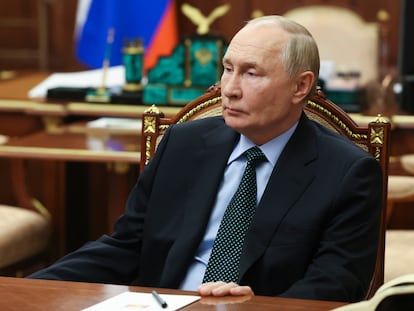Keys to the different types of missiles that are raising fears of escalation in Ukraine war
Putin reports use of new hypersonic ballistic missile against Ukrainian territory just days after Kyiv fired U.S. and British-made long-range projectiles at targets in Russia

The Ukrainian Air Force reported on Thursday the first launch of a Russian intercontinental missile along with other ballistic and cruise missiles against Ukrainian territory, a development that has raised fears of an even greater escalation of the conflict in the region. According to the local newspaper Ukrainska Pravda, the missile used was an RS-26 Rubezh, a state-of-the-art model with a range of up to 6,000 kilometers (3,728 miles) and capable of carrying a 1.2-ton nuclear warhead. However, sources from the U.S. administration denied the use of an intercontinental missile a few hours later.
The attack came after Kyiv launched its first ever strike using U.S.-supplied long-range ATACMS missiles on Russian soil on Tuesday, marking 1,000 days since the invasion of Ukraine. This was followed by the launch of British Storm Shadow missiles on Wednesday. The characteristics of each of these missiles are detailed below.
Ballistic and cruise missiles
Ballistic missiles, which can carry nuclear or conventional warheads, have a parabolic trajectory that allows them, once they have reached maximum altitude, through propulsion systems, and overcome the atmosphere, to descend at high speed, unlike cruise missiles, which move in a straight line in a regular manner and at low altitude. The shortest range ballistic missiles are the so-called tactical missiles, with a range of less than 500 kilometers (310 miles). Intercontinental ballistic missiles (ICBMs), however, exceed 5,500 kilometers (3,417 miles).
If the use of an intercontinental missile over Ukraine were confirmed — or if Moscow were to launch one at some point — Russia could send a message to the United States and its Western allies about its ability to strike, both from a distance and because it could use a nuclear warhead, although ICBMs can also use conventional warheads.
The U.S. Congress published a report in September estimating that Russia possesses 326 intercontinental ballistic missiles, whose destructive capacity could be increased by the Kremlin’s arsenal of 1,710 operational nuclear warheads.
ATACMS
On November 17, outgoing U.S. President Joe Biden gave the green light to Kyiv for the use of ATACMS (the acronym for the MGM-140 Army Tactical Missile System) on Russian territory. This is again a ballistic missile, but with a range of around 300 kilometres (186 miles). It is the longest-range missile model delivered by Washington to Ukraine. Until this week, the Ukrainian military had not been authorized to use ATACMS against targets inside Russia, although they had done so on the Crimean peninsula, illegally annexed by Moscow in 2014.
The recruitment of North Korean soldiers and the use of long-range missiles sent by Pyongyang pushed Washington to change its mind, although the use of ATACMS is restricted to the front in the Russian region of Kursk, where the Ukrainian army occupies about 650 square kilometers (250 square miles).
The ATACMS, which can carry conventional unitary or cluster warheads, have been, together with Patriot anti-aircraft defense systems and F-16s, one of Kyiv’s major requests to its American partner. These ballistic missiles can be fired from the same launchers as the Himars delivered by the U.S. to Ukraine, although the latter, also of the ballistic type, have a range of about 80 kilometres (50 miles) in the Ukrainian theater of operations. Since May of this year, following the offensive launched by Moscow in the province of Kharkiv, the Ukrainian army was authorized to use Himars against military bases on Russian soil near the border.
Storm Shadow
A day after the first ATACMS missile launch toward Russian territory, the Ukrainian Air Force attacked the Kursk area with a British Storm Shadow long-range missile, manufactured by a consortium (MBDA), consisting of a French company (Matra) and a British company (British Aerospace). The French version of this missile is called Scalp. The range of this type of missile is around 250 kilometers (155 miles). As with the ATACMS, before deploying them on the Kursk front, the Ukrainian army had successfully used Storm Shadows against targets in Crimea and the Black Sea.
Although London and Paris have not made a clear statement on the authorization given to Kyiv to use its missiles on Russian soil, the use of Storm Shadow on Wednesday against a Russian base implies that the two capitals, together with Washington — the missiles use American technology — have given their approval. Storm Shadow missiles are launched from fighter planes and have the capacity to hit bunkers or weapons depots. They fly at low altitude using guidance systems to avoid radars and detonate or drop their explosive charge once it reaches the target. According to the International Institute for Strategic Studies think tank, the main obstacle to firing these missiles is the need to mount them on Su-24M fighter planes, a model of which Ukraine only has five aircraft.
Kinzhal hypersonics
In March 2022, a month after the invasion of Ukraine, Russia launched several Kinzhal (dagger, in Russian) hypersonic missiles against the invaded country for the first time. This projectile — eight meters long, one meter in diameter, weighing 4,300 kilos and with a range of 2,000 kilometers (1,243 miles) — represented a step in the escalation of the war. Although this type of ballistic missile has not been decisive in the conflict, mainly due to the deployment of Patriot defense systems on Ukrainian territory, the speed of its flight — Kinzhals can reach Kyiv in just a few minutes — makes it difficult for citizens to predict and has spread terror among the Ukrainian population.
On Thursday, the Russian missile offensive launched against targets in the Ukrainian city of Dnipro included a Kinzhal Kh-47M2, according to information from the Ukrainian Air Force. Moscow also launched seven KH-101 missiles on the same day, of which six were intercepted. This model of cruise missile, lighter but with speeds exceeding 900 kilometers per hour (560 mph), is one of the best known and feared by Ukrainian civilians. It can fly by burning fuel in regular trajectories and with guidance systems at very low altitudes, which makes interception difficult. A KH-101 hit the Okhmatdyt children’s hospital in Kyiv last July.
Sign up for our weekly newsletter to get more English-language news coverage from EL PAÍS USA Edition
Tu suscripción se está usando en otro dispositivo
¿Quieres añadir otro usuario a tu suscripción?
Si continúas leyendo en este dispositivo, no se podrá leer en el otro.
FlechaTu suscripción se está usando en otro dispositivo y solo puedes acceder a EL PAÍS desde un dispositivo a la vez.
Si quieres compartir tu cuenta, cambia tu suscripción a la modalidad Premium, así podrás añadir otro usuario. Cada uno accederá con su propia cuenta de email, lo que os permitirá personalizar vuestra experiencia en EL PAÍS.
¿Tienes una suscripción de empresa? Accede aquí para contratar más cuentas.
En el caso de no saber quién está usando tu cuenta, te recomendamos cambiar tu contraseña aquí.
Si decides continuar compartiendo tu cuenta, este mensaje se mostrará en tu dispositivo y en el de la otra persona que está usando tu cuenta de forma indefinida, afectando a tu experiencia de lectura. Puedes consultar aquí los términos y condiciones de la suscripción digital.
More information
Archived In
Últimas noticias
‘I thought you would like it’: The risky sexual practice popularized by TV shows and TikTok
The digitalization of tourism: ‘They promise experiences and gave us the worst possible one’
Mexican peso defies uncertainty with forecasts of a new period of stability in 2026
Meghan Markle’s year of redemption: Numerous projects, some setbacks and a brand that is finally taking off
Most viewed
- Sinaloa Cartel war is taking its toll on Los Chapitos
- Oona Chaplin: ‘I told James Cameron that I was living in a treehouse and starting a permaculture project with a friend’
- Reinhard Genzel, Nobel laureate in physics: ‘One-minute videos will never give you the truth’
- Why the price of coffee has skyrocketed: from Brazilian plantations to specialty coffee houses
- Silver prices are going crazy: This is what’s fueling the rally










































